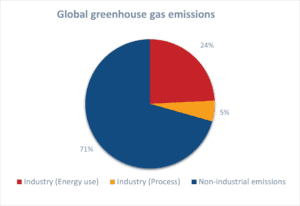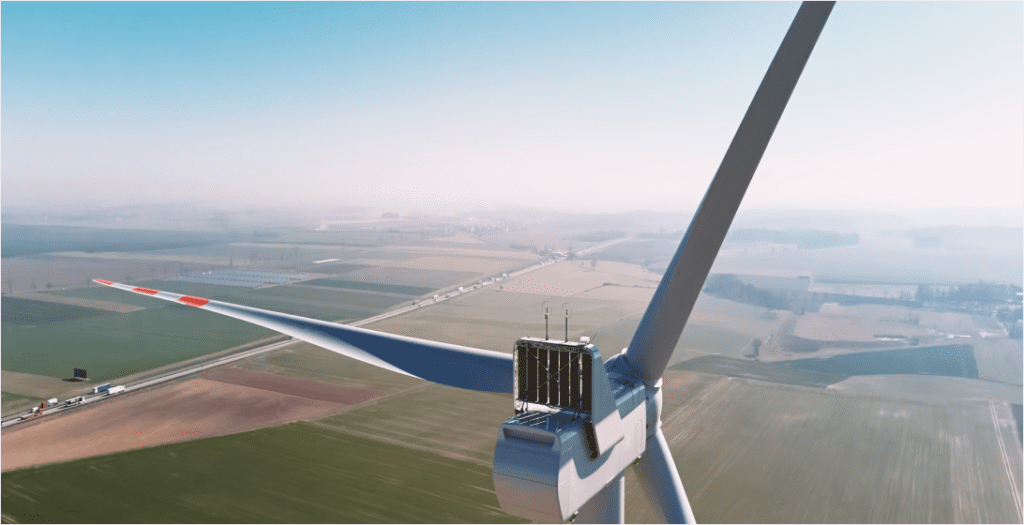According to the 6th IPCC report industrial emissions have been rising at an unprecedented rate since 2000, making it the leading polluting sector – responsible for 34% of global GHG emissions in 2019 (compared to 30% in 2010). In the 21st century, industry contributed nearly half (45%) of overall incremental global GHG emissions, driven by excessive materials extraction, fuel combustion and process emissions. Based on the trends described above, accelerated efforts towards rapid industrial decarbonization are urgently required.
Despite the alarming trends described above, some modest improvements have been made in the uptake of renewable energy or in industrial productivity as measured in value added per unit of energy consumed. Similarly, steps to formulate positive policy and innovation have also been taken such as China’s “100, 1 000, 10 000 Program” that requires large enterprises to establish energy management systems and achieve specified energy savings as well. All these factors coupled with the COVID-19 crisis brought about a 1.6% decline in direct industrial carbon emissions; however, progress towards reaching net zero emissions by 2050 is far too slow and efforts need to be accelerated to make industry more energy efficient, as highlighted by the International Energy Agency.


As per the scenario analysis shown by the IPCC report, bringing down global GHG emissions close to net zero is highly plausible by 2050 if multiple technological and other emerging options are implemented within the industrial sector. Although there is no silver bullet that can transform global industrial systems to net zero emissions, a variety of options do exist. On the technological front solutions such as electrification, fuel switching, material efficiency and carbon capture are promising measures. However, the costs of these measures are high, which makes implementation difficult, especially in challenging times.
Regardless of the various options – industrial energy efficiency, is always the most cost-effective option available in the near term and accordingly also the most relevant single aspect in the IPCC industry outlook (see chart). It produces an overall monetary benefit for the investor through immediate cost savings generated from higher energy efficiency itself. Industrial energy efficiency is also a crucial pillar of sustainable production whereby resources and the regenerative capacity of the environment are conserved whilst ensuring a smooth supply of goods. Also, energy efficiency goes hand in hand with other mitigation strategies like adopting renewable energy sources like solar power or the development of low carbon routes like hydrogen etc.
Moreover, investment in industrial energy efficiency is not just about reducing carbon emissions to become more environmentally friendly. It also has several economic and social benefits. For instance, energy efficiency investments are closely tied with economic growth as costs are reduced and production competitiveness is increased thereby generating other indirect impacts of the initial investment.
From a policy perspective, energy efficiency is well established since it has remained a key pillar in demand side management programs, energy auditing, and numerous other agreements and regulations. However, as highlighted above, industry is not on track for decarbonization. Accordingly, more and better policies are required – which also need to acknowledge certain key challenges.
For example, from a financial standpoint capital investment in industry is often difficult based on short pay back periods, a split between business units for energy efficiency projects and a lack of synchronization between state energy efficiency program cycles and industrial planning cycles. Other than that, corporate tax structures such as depreciation periods and volatile energy price trends create further uncertainty in investment returns because of which energy efficiency projects are not prioritized.
In addition, several informational gaps also exist which hamper the implementation of the available energy efficiency measures. For instance, there is lack of in-house knowledge regarding assessing the industry or company’s own energy efficiency. The absence of such assessments hinders its translation into effective energy efficiency measures and projects which are never implemented as a result. Since relevant information and expertise is not available, energy efficiency is insufficiently integrated into daily business practices. Moreover, some manufacturing plants are unaware of the incentives associated with efficiency measures available at the state and regional levels which impede deployment. Also, several entities lack disaggregated energy consumption data and tools to collect and evaluate such data. Lack of resources to hire outside staff further complicates the matter.
In order to decarbonize, it is important that industrial policy acknowledges the aforementioned challenges to make industry more energy efficient with a goal of reaching zero emissions. In the past, green industrial policy failed to recognize the magnitude of the changes required in the production, use and recycling of raw materials that were the major sources of emissions. In this regard energy efficiency policies should be designed according to the established best practices:
1. Set Targets
Targets should contribute to significant energy reductions and deliver important quantifiable results. Setting carbon reduction targets in this manner can help to meet Nationally Determined Contributions under the Paris Agreement, galvanize reduction efforts at the global level, help garner attention from relevant stakeholders and encourage innovation to reach the set target. Targets should be legally binding, ambitious and realistic to drive action towards achievement. For example, in order to speed up Germany’s bid for climate neutrality, the country’s Constitutional Court revised the target from 2050 to 2045, making it legally binding and imposing tougher emission budgets in all sectors along with new annual reduction targets for the 2030s.
2. Allocate Responsibilities
Since several stakeholders are involved in implementing energy efficiency measures, it is important to allocate responsibility according to their capabilities. For instance, energy agencies play a vital role in understanding and disseminating information needed to reduce greenhouse gas emissions and accomplish successful energy transitions. They also work closely with local entities, city councils, businesses and citizens in bringing forth and implementing innovative solutions to challenging problems like climate change. Hence, energy agencies like the European Energy Network (EEN) should stimulate policy makers and citizens to accelerate the transition towards carbon neutrality.
3. Provide Resources
Once the target is set and responsibilities allocated, it is also important to provide adequate resources like finances, specific know-how, technology and innovation etc. For example, the Global Environmental Facility (GEF) supports developing countries in making transformational shifts towards low-emission development pathways by aiding technology transfer, supporting innovation and mainstreaming mitigation concerns into sustainable development strategies.
4. Enable Rigorous Monitoring And Evaluation
Even in the presence of stringent industrial efficiency policies, transparent monitoring (collection of information to track progress towards the set progress) evaluation (systematic assessment of the policy design, implementation and results of the policy) processes are also needed to make sure that the set targets are achieved within the given time frames. Rigorous evaluation and monitoring would ensure that reliable data is collected, valuable lessons are learned and then incorporated into decision making to enhance the overall quality of the current and future policies within the efficiency domain.
5. Further Research
Efficiency policy should also have specific provisions for furthering research on problematic areas and making information about the merits and demerits of energy efficiency measures easily available to various stakeholders. A profound scientific basis is needed to provide an overall picture of energy efficiency in terms of impacts, regional differences, best practices etc.
In addition, energy efficiency policy also requires certain context specific provisions according to the preparedness and vulnerability of countries against the presumed impacts of climate change. Hence policies to decarbonize industry should also focus on fostering capacity building and targeting energy management systems to significantly optimize energy use by setting energy targets, creating action plans, and using key performance indicators to measure performance.
The European Union’s Energy Efficiency Directive 2012 can be classified as a best practice based on the scenario discussed above. It set a legally binding target of restricting the region’s energy consumption to no more than 959 million tons of oil equivalent (Mtoe) of final energy thereby reaching an energy efficiency target of 20% by 2020. The directive outlined clear responsibilities whereby all EU countries were obligated to optimize energy use at all stages of the energy chain beginning with energy generation and transmission to distribution, and end use consumption.
In tandem national energy efficiency action plans (NEEAPs) were to be formulated every three years with a mandate to achieve energy savings equivalent to annual reduction of 1.5% in national energy sales. It also imposed legal obligations on large energy companies to achieve yearly energy savings of 1.5%.
As a result of such a robust efficiency policy, the target set for 2020 was exceeded with final energy consumption reaching 907 Mtoe. After rigorous evaluation, the Directive was amended in 2018 whereby all EU countries were to collectively ensure an additional reduction of energy consumption of 9% by 2030 reaching an energy efficiency target of 36% for final energy consumption. This was done to achieve the larger aim of the EU becoming the first climate neutral continent of the world by 2050.
To conclude, energy efficiency is key for any industrial decarbonization strategy and brings along numerous further benefits. Yet, more and better policies for industrial energy efficiency are required. When their design considers the established best practices (especially considering targets, responsibilities, resources, monitoring and research) even high emission reductions will be achieved.


